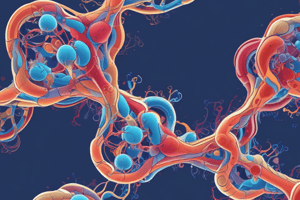Podcast
Questions and Answers
Which type of specificity refers to an enzyme acting on only one substrate?
Which type of specificity refers to an enzyme acting on only one substrate?
- Regulation specificity
- Bond specificity
- Location specificity
- Absolute specificity (correct)
Which type of specificity involves enzymes acting on specific bonds or linkages?
Which type of specificity involves enzymes acting on specific bonds or linkages?
- Location specificity
- Regulation specificity
- Absolute specificity
- Bond specificity (correct)
Enzyme activity can be regulated to respond to cellular needs. Which characteristic does this exemplify?
Enzyme activity can be regulated to respond to cellular needs. Which characteristic does this exemplify?
- Coenzyme function
- Prosthetic group involvement
- Rate-limiting step control (correct)
- Isozyme activity
What term is used to describe the collective term for coenzymes and cofactors that are essential for enzyme function?
What term is used to describe the collective term for coenzymes and cofactors that are essential for enzyme function?
Which term describes an enzyme with its required prosthetic group or coenzyme attached?
Which term describes an enzyme with its required prosthetic group or coenzyme attached?
Compartmentalization of enzymes within specific organelles serves which purpose?
Compartmentalization of enzymes within specific organelles serves which purpose?
What term is used to describe the non-protein part that is tightly bound to the apoenzyme and is difficult to remove without damaging the enzyme?
What term is used to describe the non-protein part that is tightly bound to the apoenzyme and is difficult to remove without damaging the enzyme?
Which of the following best describes isozymes (isozymes)?
Which of the following best describes isozymes (isozymes)?
What sets the pace for the entire enzymatic reaction, as it is usually the slowest step?
What sets the pace for the entire enzymatic reaction, as it is usually the slowest step?
Which term refers to the fully active form of an enzyme consisting of both the protein part and its bound cofactor/prosthetic group?
Which term refers to the fully active form of an enzyme consisting of both the protein part and its bound cofactor/prosthetic group?
In an enzymatic reaction, what is a coenzyme?
In an enzymatic reaction, what is a coenzyme?
What primarily constitutes an apoenzyme?
What primarily constitutes an apoenzyme?
What is the main difference between holoenzymes and apoenzymes?
What is the main difference between holoenzymes and apoenzymes?
Which of the following is a characteristic of coenzymes in enzymes?
Which of the following is a characteristic of coenzymes in enzymes?
What role do cofactors play in enzyme function?
What role do cofactors play in enzyme function?
What is the significance of isozymes in metabolic reactions?
What is the significance of isozymes in metabolic reactions?
In enzymatic reactions, what is the function of a prosthetic group?
In enzymatic reactions, what is the function of a prosthetic group?
Which statement accurately describes the concept of rate-limiting steps in metabolic reactions?
Which statement accurately describes the concept of rate-limiting steps in metabolic reactions?
Flashcards are hidden until you start studying




